|
SUGAR AND SPICE,
BUT NOT VERY NICE -
HOW HAWAII FELL INTO
AMERICAN
HANDS |
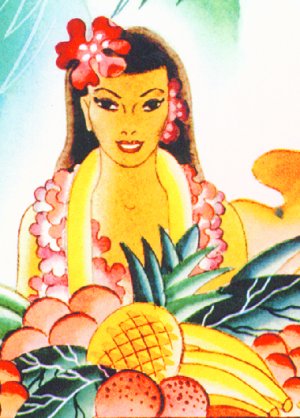 |
|
"They paved Paradise and put up a parking
lot." -
Joni Mitchell
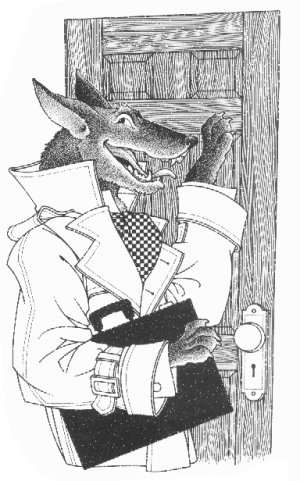 |
Thanks to Captain Cook, the word had gotten out.
Now everyone knew about Hawaii, the Jewel of the Pacific. And soon
everyone came courting.
As I leafed through the history books, during the 1800s every great
power took a run at Hawaii. Great Britain, France, Russia,
Japan, and of course the United States all came knocking at the
door. Since we already know who the winner was, I thought you
would at least be interested to find out how it happened.
The Great King Kamehemeha had the amazing natural ability to keep
the visitors at arms length, but his successors didn't seem to have
his instincts. They certainly did not do anywhere near as good
a job of keeping the wolves at bay.
Slowly but surely the wolves came closer... and closer.
However, in the end the Big Bad Wolf didn't knock the door down and
conquer Hawaii by force. Ultimately Hawaii was
conquered from within.
The story of Hawaii has always played out like a Darwinian struggle.
First the Marquesasian people moved in. Eight hundred years
later the Tahitians came calling and completely devastated the native
people, turning them into slaves. In the 1800s it seemed like the same
thing was happening all over again.
Except that this time the conquest was all done in a civilized
manner. There was absolutely no bloodshed. But make no mistake
about it - the same ruthlessness was still definitely present.
It was sugar and spice, but not very nice.
|
THE EROSION OF THE
KAMEHAMEHA DYNASTY
The
Kamehameha dynasty ran from 1795 till 1872.
Kamehameha I ruled from 1795 to 1819. As I
have
written, this was
the man who united the islands. After his death in
1819, the Hawaiian Islands were ruled by his successors through
much of the 1800s. Each of the next four "Roman Numeral" Kamehamehas did the best they could, but quite frankly Hawaii
was headed towards very hard times.
Kamehameha II ruled from 1819 to 1824. Known as
Liholiho, was King Kamehameha's successor.
His major accomplishment was to transition the Hawaiian
people away from pagan worship. No more sacrificial altar,
no more pagan gods, no more Pele. Within six months
after assuming the throne as Kamehameha II, the religious and
political code of old Hawaii, collectively called the kapu
system, was abolished.
Liholiho not only ended the pagan beliefs and rituals,
but in the process was able to give women equal rights
in society for the first time. By liberating the people from the crazy
taboos of kapu, now for the first time women could actually
be permitted to sit
down and eat alongside their men!
There is an interesting anecdote about how Liholiho got the
courage to toss the pagan beliefs aside. Apparently from
infancy, Liholiho had observed that the visiting sea captains
were able to break every taboo regarding Hawaiian women with
total impunity. The visiting men behaved very badly, yet
they never seemed to get punished! Why did Pele, the
meanest goddess of all, take it so easy on these guys?
Meanwhile the women in his court were pressuring him to do
something about these ridiculous taboos.
So one night Liholiho decided to try an experiment. He sat
down with the women of his court for dinner and waited for the
sky to fall in. Not only did the roof hold and the volcano stay quiet, no
one died from food poisoning either. Very interesting, he
thought.
Liholiho continued to eat meals with the women of the court
including Queen Kaahumanu.
Although she was not Liholiho's actual mother, Queen
Kaahumanu was the most powerful woman in the
kingdom. As the widow of King Kamehameha, when she spoke,
everyone listened. It was at her insistence that Liholiho
got the inspiration to consider abolishing the old customs.
Between the lines, it appeared Liholiho was more frightened of
this woman than he was of the wrath of the mythical gods.
The Queen was a fire-breathing monster on this kapu
issue! If he didn't get rid of this kapu, he might soon be
kaput.
Pretty soon Liholiho had worked up the
courage to get rid of all the taboos. Now, for example,
the women could actually eat bananas for the first time!
That's right - the women were allowed to collect the bananas and
cook the bananas, but they couldn't eat them. The women were so happy at the changes, they celebrated
raucously and went crazy... which is where the term 'going
bananas' got its start (I couldn't resist).
On a more serious note, it took a lot of guts to throw out principles that had been
practiced for centuries. Note for example
how difficult it is to make similar accomplishments in certain
Muslim countries. Once people are convinced that God Allah
Jehovah etc wants things a certain way, it isn't easy for mere
mortals to make changes. A lot of people have died over
the centuries for reasons based on religious beliefs and
superstitions.
The wags would say that Liholiho met a
force greater than God - Women - but all kidding aside, Liholiho
deserved a lot of credit for setting aside the old ways of his
people.
Liholiho seemed to have a lot of talent, but he only ruled for
five years.
|
His successor, Kamehameha III (1825-1854) was considered the best
ruler of Kamehameha's descendants. Known as
Kauikeaouli, his reign of 30 years could hardly be
considered a time of happiness in the kingdom. When he
ascended to the throne at age 11 in 1825, Hawaii's population
was at 150,000 - perhaps one-third the size it had been upon
Cook's arrival in 1778. During his reign, a horrible smallpox
epidemic (1852) reduced the population to half that size at 75,000.
The scourge of the Europeans was wreaking havoc with Hawaiian
society. A veritable Pandora's Box of plagues had been
unleashed by the visitors.
At this point, the sandalwood economy had been replaced by
whaling as the major industry. Not only did the sailors
absolutely terrify the natives with their drunken sprees, they
had a nasty present to share. In 1827 the American whaling
ship "Wellington" introduced mosquitoes to Hawaii. The hadn't
caught any whales, so their barrels were still full with water
instead of fat. They dumped the mosquito infected water in a
river and replaced theirs with fresh water. In the process
they unwittingly introduced the mosquito to Hawaii (and yes, to
answer your question, the rats and cockroaches were already
there thanks to James Cook).
So much for Paradise. The
stupidity of human beings seems unfathomable at times!
1827 was also the year the first Catholic missionaries arrived.
This was a pretty remarkable coincidence because just a couple
years earlier Liholiho had abolished paganism. But he
hadn't replaced the old religion with a new system. So the
Catholic missionaries had a religious vacuum just waiting for
them. Liholiho's successor Kamehameha III did everything he could to help his people adjust
to the new religion.
Kamehameha III's major accomplishment was to introduce modern law into the society,
including the first Constitution, the first legislature, and a
declaration of the rights of citizens.
Perhaps
Kamehameha III's most significant move was issuing the Great Mahele
of 1848. This edict was meant to redistributed land between the government,
king, nobles, and commoners. This act would allow common
people to own the title to their land for the first time. In
other words, the native people could now become landowners and
establish a powerful legal foothold in society.
Unfortunately, no matter how noble the intent, this move
ultimately backfired. Apparently
Kamehameha III forgot to send the email to the different
islands. Most commoners were
either ignorant or totally unaware of this important program.
Therefore the little people lost out on the
distribution process, aka the Big Land Grab.
Even more ominous, foreigners were now allowed
to own Hawaiian land for the very first time. And unlike
the Little People, they were completely aware of the
long-reaching consequences of this edict.
Mind you, the Great King Kamehameha had aggressively resisted giving
foreigners any control of Hawaiian land, making it clear that
each and every foreigner was a 'visitor'. Mind you, people
were allowed to 'lease' their land and many foreigners did put
down roots. But King Kamehameha also made it clear those roots could
be removed if he thought it wise to do so. As a result,
all foreigners tiptoed around the Great King Kamehameha like
they were walking on hot volcano lava.
It was not instantaneous, but the Great Mahale of 1848 would
change the course of history in Hawaii. Surely Kamehameha
turned over in his grave now that his successor had given away
the farm.
Kamehameha IV, aka Alexander Liholiho, ruled from
1854-1863. The Whaling Era was nearly over. Now thanks to the Great Mahale
of 1848 passed by his predecessor, it was on his watch that the
Sugar Industry began to take hold.
Alexander Liholiho was no fool. In fact, he appeared to be
very talented. He could definitely see what was happening.
The king abhorred the increasing amount of influence that the
Americans were enjoying in his kingdom and
correctly feared that if left unchecked
the United States might take over his nation.
As a result,
the King sought to
cultivate a stronger relationship with Britain as a way to
balance the power of the Americans. He
also strived to find other ways to lessen Hawaii’s dependence on
the U.S. So what went wrong?
A tragedy intervened. In August,
1862, his only son threw a temper
tantrum. His annoyed father
decided to cool him off by placing him under a cold water
faucet. Shortly after the dousing, the child became sick with a
high fever. Ten days, later, the prince was dead.
Overcome with grief and guilt, Kamehameha IV became a
recluse and withdrew from public life. A
year later, on November 30, 1863, after years of suffering from
nerve disorders and asthma, the king died unexpectedly.
He was only 29.
Since he left no direct heirs, it was
up to his brother to take over.
|
Kamehameha V ruled from 1863-1872.
Also known as Lot Kapuiwa, other than some building projects, his reign appears to have been
deeply unremarkable. His only significant accomplishment was
accomplishing nothing - he failed to produce an heir!
When Kamehameha V died in 1872,
the House of Kamehameha had come to its end. The
dynasty was over.
|
|
SUGAR AND SPICE BUT NOT VERY
NICE -
THE SUGAR PLANTATIONS SPREAD THEIR POWER
Sugar and Pineapple were the backbones of the
Hawaiian economy for over a century.
Many different crops were attempted (cotton, tobacco, corn, sisal,
rubber, and silk among others), but failed to thrive.
However
it was discovered that sugar cane and pineapple were two crops that
were perfectly suited to the Hawaiian climate and soil.
At one point Hawaii produced 75% of the entire world's sugar and pineapple
production.
Unfortunately the power vacuum created by Kamehameha V had dealt the
people of Hawaii a cruel blow. The next group of leaders
were not very effective at all. One by one, they
relaxed the hold of the Hawaii people on the reins of power.
|
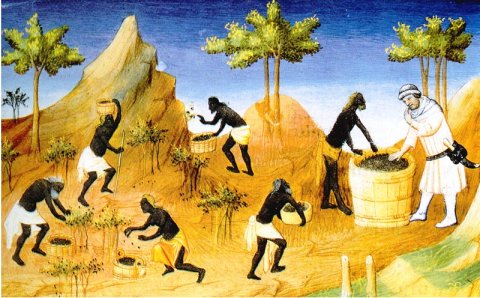 |
King Lunalilo was chosen by election in the
legislature. Two related issues occupied much of
Lunalilo’s reign as king. Hawaii’s growing sugar industry
required a natural market to absorb its increasing production,
and Lunalilo worked to give Hawaiian sugar unhindered and
untaxed access to the American market. At the same time,
American use of Pearl Harbor on Oahu was openly considered in
exchange for the reciprocity treaty. In April 1873, the American
businessmen proposed the idea of ceding the harbor to the U.S.
Lunalilo, acting on the advice of his advisers, seemed ready to
cede the land for the economical benefits of reciprocity.
However, a vast majority of the native Hawaiians were deeply
opposed to both moved. A rising swell of opposition by
Hawaiians forced him to reconsider. The king’s reputation was
tarnished in the eyes of his people.
However, none of it mattered much. Lunalilo had a serious drinking problem. He lasted
all of two years, dying in 1874 at the age 39.
|
Next came King Kalakaua.
Since Lunalilo had appointed no successor either, it was time to elect a new King (since when are Kings elected?).
This time the Sugar interests
helped elect Kalakaua to the Hawaiian
throne over the British-leaning Queen Emma in February 1874.
Another election was held, and Kalakaua won handily over
Queen Emma, widow of Kamehameha IV.
Supporters of the queen rioted. Kalakaua
was not popular with the people because he was incompetent and
because he was seen as being in the pocket of the distrusted
American businessmen. Guess what? The people were
right on both accounts.
Kalakaua requested help from American warships in the
harbor and the uprising was quelled. Because
of the ill feelings, however, the new king’s plans for a lavish
celebration were put on hold.
Despite the shaky start, Kalakaua
was unfazed. With his conscience
unimpaired by any need to keep an eye on his kingdom,
King Kalakaua earned the reputation as the Merry Monarch. He ruled for
the next twenty years, but preferred to spend most of his time
playing and traveling abroad. He had a passion for
music, dancing, parties, and the finest food and drinks.
The king’s reign was also marked by tragedy, pain and dark
clouds hovering over the Hawaiian kingdom.
It was on his watch that the Sugar Kings began to take total
control.
Knowing exactly who his backers were, Kalakaua's first contribution was to
make business conditions better for his businessmen cronies.
Kalakaua immediately sought a trade agreement with the
United States that would make the production
of sugar even more profitable than it already was.
In late 1874, Kalakaua sailed to the United States amid much
fanfare. In Washington, he negotiated the Reciprocity Treaty of
1875, which eliminated the tariff on sugar and other Hawaiian
products.
In addition, the Reciprocity Treaty of
1875 included a provision that would allow
the U.S. Government the opportunity to fortify or use Pearl
Harbor as a naval base. Taking note that 90% of all
merchant ships coming and leaving Oahu were American, a US
warship was assigned to patrol the Hawaiian waters at all time.
The Sugar Men had what they wanted - closer economic ties with
the United States and American muscle to watch their backs.
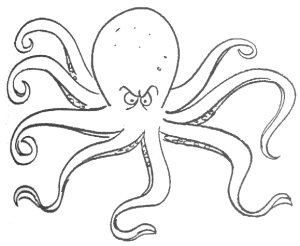 |
This Treaty paved the way for the Golden Age of the
Sugar Plantations. As a result, Hawaii’s sugar
industry boomed and the kingdom enjoyed a period of economic
prosperity. American businessmen began buying up
all the land they could get their hands on to create more sugar
crops. Thanks in part to Kalakaua's frequent absence from
the islands, over the next twenty years the
sugar plantation owners dramatically increased their
hold on Hawaiian real estate and politics. They literally
had their tentacles in every single corner of Hawaiian life.
Sugar was a very profitable crop. Someone once suggested
sugar was more valuable than gold. Sure enough, by the end
of the 19th century, commoners and chiefs had sold, lost, or
given up their lands, with foreigners and large estates owning
most non-government lands.
|
Sugar soon brought a significant... and quite ominous... change
to Hawaii. Because much of the work on the sugar
plantations was done by hand, the expansion of the sugar
industry required a considerable increase in the labor force.
The native Hawaiian population had
continued to decline throughout the 19th century, largely due to
disease. The numbers were around 75,000
in 1852. Now by 1872 it
had fallen to about 50,000. In
addition, many native Hawaiians were unwilling to work as
laborers for white planters.
At
the time, there were only about 5,000 non-Hawaiians living in
the islands. That was about to change
in a dramatic way.
This labor imbalance created a situation eerily similar to the United States'
current immigration headache with Mexico. Over the next
few years,
Hawaii saw an enormous influx of newcomers introduced into their
society.
After the sugar trade treaty was signed in 1876, the Hawaiian
government sought to alleviate the labor shortage by the
large-scale recruiting of foreign workers. Initially,
recruitment efforts centered on Chinese laborers; about 20,000
to 25,000, including about 8,000 Chinese from California, were
brought to Hawaii on contract. However, once their enlistment
was over, the Chinese frequently showed more inclination to
establish businesses of their own than to continue working on
the plantations.
Recruiting then concentrated on the Japanese;
about 180,000 Japanese were brought to the islands between 1886,
when Japan agreed by treaty to allow laborers to migrate to
Hawaii, and 1908, when a United States-Japanese agreement
brought the migration to an end. When their contracts expired,
most of the Japanese either returned home or migrated to the
U.S. mainland, but about one-third chose to stay in the islands.
Meanwhile the growth of the sugar industry concentrated economic and
political power in the hands of a few families, mostly white
settlers and their descendants. Many of these
whites favored a closer relationship between Hawaii and the
United States, in part to guarantee continued
privileged access to the giant
sugar market in the states.
Like the cattle barons of the Old West, it was about this time that the Sugar plantation owners
basically started calling the shots.
In 1887 a secret organization called the Hawaiian League
was formed. Made up mostly with American businessmen, this
group
wanted to limit the monarch's authority or abolish the monarchy
all together. They also wanted to pursue an eventual annexation by
The US. This group had military backup in the form of a homegrown armed
militia known as the Hawaiian Rifles.
In July 1887, the Hawaiian League forcibly took control
of the government and presented the king with a new
constitution. Called the
Bayonet Constitution (for obvious reasons), Kalakaua had
little choice but to sign it or face the
Hawaiian Rifles. The new
constitution severely restricted his powers and signaled the end
of the monarchy. This nasty piece of
legislation concentrated all voting power in the hands of the
moneyed interests. Hawaii had become an oligarchy run by
the American businessmen.
The Merry Monarch was King in name only from that point on.
He mostly traveled for the final four years. He died in
San Francisco in 1891. His final words were, "Tell
my people I tried."
Upon Kalakaua's death in 1891, his sister Queen Liliuokalani
took over.
Queen
Liliuokalani was appalled at all the power her
useless brother
had squandered away. She took immediate steps to reinstate
the power of the monarchy.
Unfortunately under the Bayonet Constitution
her brother had signed, Liliuokalani wielded little power.
Every move she made was blocked. She
formed a Cabinet three times. Each
time it was rejected by the Sugar-controlled
Legislature. She drafted a strongly royalist constitution,
but no one supported it either.
But her biggest mistake was making the
rounds of foreign embassies in search of outside support. What
was she up to?
Liliuokalani was raising a lot of
suspicion. She was becoming a real pest! Didn't she
realize this was
their Hawaii now!
The sugar owners on the islands were well aware that other foreign
powers were circling these waters. Russia had built forts on
Kauai. France had attempted a military takeover. England
had an actual treaty dating back to Kamehameha I that said Hawaii
was an English protectorate. On one occasion England had
occupied Hawaii militarily only to change its mind at the last
minute and recall the troops. Even Japan had threatened to take
over Hawaii and had extracted an indemnity in the process.
|
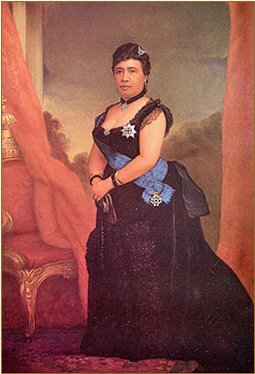 |
 |
Since Hawaii had absolutely no military force of its own, any
country with a navy and a strong will could have taken it by force
in the blink of an eyelash.
The American businessmen decided they had had enough of the
Queen's meddling in their affairs. The Islands under
American leadership had grown too modern, too valuable, and too
important to allow the Queen to risk upsetting everything they had
worked for.
Even more irritating, the American government had recently removed
the favored status of Hawaiian sugar. Only if Hawaii became an
American territory would their prosperity be renewed. But it
was obvious that Queen Liliuokalani would
never agree to this.
The Hawaiian League decided
she had to go. It was time to make these islands their
own! They had the money, they had the power, and they had the
incentive to make this happen. They were sick and tired of
this silly woman getting in their way.
|
The die was cast. In 1893, Queen Liliuokalani
was overthrown in a bloodless coup.
On the afternoon of January 16, 1893, 162 sailors and Marines aboard
the USS Boston in Honolulu Harbor came ashore under orders of
neutrality. The real reason behind the presence of these troops,
ostensibly to enforce neutrality and prevent violence, was to
effectively make it impossible for the monarchy to protect itself.
It was a thinly-disguised military takeover.
Queen Liliuokalani
was absolutely stunned. She never saw this coming.
She was so busy trying to do what was right for her country that
she was having trouble reading the writing on the wall. In
the process she failed to realized how badly her aggressive
anti-American actions had
irritated the American businessmen.
On January 17, 1893, pro-American forces overthrew the
government and proclaimed a provisionist government with Sanford
B. Dole (of Pineapple fame) as president.
Liliuokalani had no choice but to surrender her throne
to "the superior military forces of the United States".
Queen Liliuokalani
decided her only chance was to use politics.
Her only hope was that the United States, like Great Britain earlier
on in Hawaiian history, would restore Hawaii's sovereignty to the
rightful holder. She made
a plea to the U.S. government for reinstatement.
Amazingly, a
commission authorized by President Grover Cleveland
indeed found the overthrow
to be illegal. It said that U.S.
Minister Stevens and American military troops had acted
inappropriately in support of those who carried out the overthrow.
On November 16, 1893 Cleveland proposed to return the throne back to
her if she would grant amnesty to everyone responsible. She
initially refused, and it was reported that she said she would have
them beheaded - she denied that specific accusation, but admitted
that she intended them to suffer the punishment of death. She
should have kept her mouth shut!
Furthermore Sanford B. Dole refused to accept the decision.
He just kept on ruling no matter what the President had ordered.
These two developments effectively neutralized Cleveland's order.
Now Congress got involved. Congress responded to Cleveland's
referral with another investigation. Bad news - the Senate
found all parties (including Minister Stevens) "not guilty" from any
responsibility for the overthrow. In other words, this time
the overthrow was considered a legal act.
The Queen withdrew to her residence
and urged
her supporters to be patient and avoid bloodshed.
Nevertheless a fierce
uprising was firmly squelched in January 1895.
Although the Queen
denied playing a role in the attempted takeover, Liliuokalani
was arrested. She was taken to a second-floor room at
the Iolani Palace which would serve as her jail cell for nearly a
year.
During her confinement, the queen wrote one of Hawaii’s
most beloved songs, "Aloha Oe" ("Farewell to Thee").
Liliuokalani was pardoned a year later
in October 1896. In her remaining
years, the deposed queen continued to fight
in vain for the restoration of the
Hawaiian kingdom. However she refused
to resort to violence. She would not let anyone risk dying on
her behalf.
For the next twenty years, she worked on behalf of the Hawaiian
people to improve their lives any way she could. She died in 1917 at age 79.
Upon her death, Queen Liliuokalani
was a much beloved figure in her homeland.
She wasn't much of a politician, but she was a very decent person.
Her death symbolized the end of an era.
|
THE TWENTIETH
CENTURY
The 1800s had been a very rough time for the
native Hawaiians. They had lost their original religion,
disease had decimated their population and the constant flow of
newcomers to their island made them feel like strangers in their own
land. Adding insult to injury, thanks to the secret
organizations led by the American sugar and pineapple plantation
owners, they no longer held any real power in their own land either.
The people may have been downtrodden, but the Sugar Barons were
swift to take advantage of the fruits of their dirty work. Now
that they had complete control, at the turn of the century the
plantation owners started to merge their businesses.
The start of the 1900s saw the sugarcane plantations gain a new
infusion of investment. By getting rid of tariffs imposed on
sugarcane producers by the United States, planters had more money to
spend on equipment, land and labor. Increased capital resulted in
increased production. After all the wheeling and dealing, 5
Companies emerged as the winners. These Five kingdom-era
corporations benefited from annexation, becoming multi-million
dollar conglomerations overnight.
The men who ran these companies totally dominated the islands for
the next sixty years. Since Hawaii was a territory, they were
not under the thumb of the US government per se. Therefore
these five companies enjoyed practically total freedom in their
manipulation of Hawaiian politics and economy.
The companies did not compete with each other but rather cooperated
to keep the prices on their goods and services high. Their
profits skyrocketed even more. Soon, the executives of the Big Five
sat on each others' boards of directors. With economic power
came political power over Hawaii. The companies decided who got
elected. The companies lobbied in Washington as one. These Big
Five corporations together became a single dominating force in
Hawaii.
Left unchecked, these virtual oligarchies made some men very
rich. One man for example, Jim Dole the Pineapple King, became
so wealthy he was able to purchase the entire island of Lanai!
Fortunately the wealth of the Big Five seemed to trickle down
to the general populace as well. Helped along by two new
economies - coffee and tourism - the standard of living in Hawaii
rose considerably throughout the Twentieth Century.
Oddly enough, it was the tragedy of Pearl Harbor in 1941 that
helped break the stranglehold of the Big Five. For the first
time, people on the U.S. mainland fully recognized the
importance of Hawaii to the rest of the country. As
the people of Hawaii served faithfully and with patriotic
zeal throughout World War II,
people throughout the Lower 48 were genuinely
impressed by the effort.
Using this newfound popularity and strategic value to great effect,
it became only a matter of time before statehood was bestowed on
Hawaii in 1959.
|
 |
The changes were immediate. Statehood restored citizenship
rights to the native Hawaiians. They began to have more
political power now than at any time since the Great Mahale of
1848 from the previous century had started their path to ruin.
Furthermore, the decline of sugar and pineapple in the late
Twentieth Century crippled the great economic hold of the Big
Five. The price of labor for sugarcane workers in Hawaii
was the now highest in the world! Right and left the sugar
and pineapple plantations closed down to move operations to
areas like Brazil and the Philippines where labor was cheap.
In the minds of many Hawaiians, good riddance.
Today Hawaii shines brightly again. Although the native
Hawaiians comprise only 16% of the population, they enjoy a
status far greater than our own American Indians who suffered a
similar fate in the 1800s. The Native Hawaiians are such a
tightly knit group that they literally seem to have veto power
over all businesses. For example, while I was in Oahu, I
read a story about a Wal-Mart project that was brought to an
entire halt for weeks when some native bones were accidentally
discovered!
It is obvious the native Hawaiians are going to make sure that
their ancestral homeland is protected from environmental abuse
and exploitation. They are educated, politically savvy,
and deeply united in their efforts to make sure the Jewel of the
Pacific stays that way from now on.
And you know what? I am completely in their corner.
I want Hawaii preserved just as much as they do.
Because, just in case you haven't figured it out by now, I am a
big fan of Hawaii.
|
|